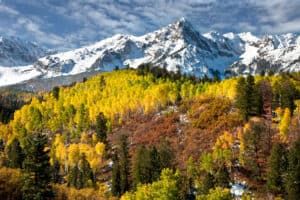
You might be thinking, “Wow! The state of California is so expensive. I don’t know how people live there.”
You’re not alone in your opinion.
California is the fiscally largest state in the United States, with more than 37 million people.
With that many people and that much landmass, there’s almost an equally good amount of industry, entertainment, and resources to spend money on.
Let’s see why it’s so expensive to live in California.
Why Is California So Expensive? (Top 20 Reasons)

California is home to various land formations, parks, high-powered industries, entertainment, and technological hubs.
Combine this with California’s mild weather and coastline, and you have a very desirable place to live.
California’s costs boil down to convenience for just about every lifestyle and preference you can think of in addition to good weather for most of the year.
1. The Idea Of Possibility And Finding Yourself

What do you dream of doing for a living?
Do you want to do it in an area of the world that favors those conditions?
California has a lot to offer in terms of opportunity with the varied landscape and weather patterns, which provides a little something for everyone year-round.
Many newcomers arrive in California with an idea of what they want to do, only to learn that even more possibilities exist because California is so diverse in its geographical landscape.
Many first-time visitors gravitate to well-known spots based on their likes and preferences.
- Budding vineyard growers may visit Napa Valley.
- Aspiring actors and actresses may flock to Los Angeles.
- Beachgoers might try San Diego on for size.
- Surfers might dip their toes off the coast of Huntington Beach.
- Members of the LGBTQ community might start in the San Francisco area.
- People who want to escape to the forested mountains might enjoy the Mt. Shasta region or Big Bear Lake.
- Members of the art community might flock to Ventura County.
Other people come to California later in life seeking a complete change of pace and environment from what they were used to.
Some people are looking to start fresh in California or even retire.
2. The Weather In California Is Mild Year-Round

There are exceptions to this, of course.
The eastern portions of California are a little drier, and in the southeast, scorching deserts exist.
The western part of California is mainly right on the Pacific Ocean or just 100 or so miles in from the sea.
This geographical layout keeps the weather patterns somewhat predictable.
In the winter months, temperatures are usually between 50 and 60 degrees Fahrenheit with moderate rainfall in some regions.
During this time of year, many Californians head south for a little more sunshine or to escape the chilly conditions up north near the mountains.
Spring is dryer than winter, and the temperatures can hang at roughly 80 degrees Fahrenheit.
Unlike the Pacific Northwest, where rainfall is present for much of the year, the rainy season is short in California, from April to June.
This comfortable climate allows individuals to stay outdoors longer during more months of the year and enjoy the variety California offers.
3. The Pacific Ocean Borders All Of California To The West

California’s coastline is more than 840 miles long.
That much coastal property means that there are many beaches to explore, with the best weather and views for much of the year, in a variety of different landscapes.
The ocean provides endless options, from swimming to surfing to fishing or just taking in all the sights up close by boat.
For people who are more up north, the Central Coast has much to offer with its temperate climate and picturesque views along Highway 101, which winds through Monterey Bay before making a dramatic turn south towards Big Sur.
Many visitors stop in Los Angeles before heading down to San Diego, where they may spend their days by the water enjoying fish tacos (and maybe even going surfing).
Later in the day, they might spend time admiring palm trees towering overhead against an azure blue sky—not too shabby!
The mild climate along most coastal areas has allowed California beach towns like Malibu, Santa Barbara, and Santa Monica to become tourist hotspots.
These cities also function as home bases for those who want easy access to surfing spots on shorelines where waves regularly rise without ever really dying down.
Huntington Beach is another popular spot for surfers and other thrill-seekers because it offers excellent waves and sand dunes, providing other adventures such as hang gliding and sandboarding.
Being this close to the ocean also means endless possibilities for obtaining seafood, whether on a boat or from nearby beachside restaurants.
4. Well-Known And Famous Restaurants

The Pacific Coast offers some great culinary experiences that can be enjoyed any time of year.
Because of the proximity to fresh seafood year-round, along with California’s large swath of ethnic diversity, California is home to several well-known and famous restaurants.
One renowned restaurant in Northern California is The French Laundry, which has been awarded three Michelin Stars and is known for its cuisine and ambiance.
The restaurant operates out of a two-story stone building built in 1890 that used to house a pioneer laundry service.
People looking for a great meal in Central California should investigate Carmel Valley.
Restaurants here boast old-world flavors, artistic spins, and modern flair.
In Southern California, one of many famous eating meccas is The Palm Restaurant, which can be found in Beverly Hills.
This restaurant is renowned for its American Cuisine and for being a Hollywood institution.
5. Hollywood Was Born Here

One of the biggest reasons California is so expensive is that Hollywood was essentially born here.
The movie industry has its earliest feats based in the Los Angeles area, and Hollywood is a notorious part of Southern California culture.
Many famous actors and actresses make their homes in this part of California, which in turn, pumps even more money into the economy.
Wealthy residents and tourists flocking to the area mean that businesses can charge more in this area of California as many of the residents have the means to pay for it.
6. Silicon Valley: A Concentrated Tech Hub

Silicon Valley has been the home of many of the technological advancements that we see today.
Advancements that originated in California include the microchip, the personal computer, and small mobile devices.
This area of California has become home to a concentrated segment of the technology companies that have shaped this industry.
These contributions are why Silicon Valley has been a significant economic engine for California and why it continues to grow in importance.
7. Higher Wages Than Other Parts Of The United States

The wages for workers are higher than in other parts of the country.
Silicon Valley attracts talented developers and engineers who can work at world-class companies like Google or Facebook.
https://www.youtube.com/watch?v=Dyhpr8KjP4o
For example, some salaried technology workers make an average annual wage of $124,000, whereas, in other parts of the United States, this same technology worker would only make an average of $70,000.
With such high-paying positions available, it’s only reasonable to understand that other prices will increase as there are higher wages to pay for them.
8. The Real Estate Market Is In High Demand

The real estate market comes with high demand as well.
This also promotes a higher cost for housing.
Besides the high cost of living, many people also associate expensive living and lavish lifestyles with Hollywood.
It’s well known that celebrities make their homes in the area.
Having many stars in the area drives people to purchase homes in the surrounding areas to be near affluent society, to have the hopes of meeting celebrities in person, and for those aspiring to break into the entertainment industry, to be successful.
In the Silicon Valley area, prices for having a roof over your head are astronomical compared to, say, the Midwest of the United States.
9. High Cost Of Property Tax And Other Taxes

Each county has its own set of property taxes.
Some counties charge an annual property tax and a per capita parcel tax that can be assessed locally.
In California, some counties assess what is locally known as “improvement assessment,” or taxes on new construction only.
These extra taxes have led to higher housing prices and inflated assessments of home values, primarily in Northern California.
Because of the large amounts of money people are paying to live here, some places in California have enacted a luxury tax on properties priced over $1 million to dissuade wealthy people from leaving.
For renters, this means increased rental prices as property owners mostly pass these expenses down to them.
These additional factors lead to remarkably high rental costs, which can be challenging to pay for California’s non-wealthy families.
Combine this with taxes everyone must pay, such as a state income tax or a county income tax depending on where they live within the state of California, and it means even more expense.
These stacks of taxes make it extra expensive for people who own homes in the coastal region of America’s most populous state.
10. High Homelessness And Unsheltered Rate

With so many people living in California, coupled with the high cost of living, it’s only natural that California has one of the highest homelessness and unsheltered rates of anywhere else in the nation.
Affordable housing has been decreasing throughout the state due to higher wages and costs associated with renting and buying homes while simultaneously receiving fewer hours at work due to remote working opportunities available through the internet.
California’s homeless population accounts for 28 percent of all homelessness in the United States.
Fifty percent of the country’s unsheltered population resides in California.
These high rates are caused by economic factors such as a high cost of living, lack of affordable housing, and low wages.
California’s homeless population is also seen as a significant problem.
Because the major cities are so vast, it can be challenging to find or create shelters for them in an area that doesn’t clash with sheltered locals or disrupt their lifestyle.
11. High Poverty Rates

Because much of California has lower wages than the higher-end areas of the state and the cost of living is so high, many residents live below the poverty line.
Currently, roughly one out of every six residents lives below the poverty line.
The high cost of living in California has led many working families with lower incomes into poverty because their wages could not keep up with the rapid inflation rates.
Higher prices on goods and services, like rent or groceries, mean that even though they work hard, there may be nothing left over from each paycheck after paying those bills.
This combination of cascading factors leaves them struggling to get by every month, sometimes barely making ends meet while never saving any money for emergencies such as car repairs or medical expenses.
In turn, this leads to more people applying for various governmental assistance programs.
More demand for governmental assistance programs leads to an increased demand for funding, leading to higher taxes and solicitations for donations.
The one good thing about California’s poverty rate is how local governments offer many programs to help restore a family’s financial situation.
For example, some government-sponsored job programs provide employment opportunities at minimum wage.
These programs offer job training and preparation services free of charge while helping people become self-sufficient members of society once more.
12. Pay To Park

Everyone wants a slice of the high wages and the wealthy lifestyles California offers, including counties that charge for parking on the city streets.
Parking fees are an added expense that many places in the country only have in small portions of their local areas.
In California, most businesses in the state require some form of payment to park a vehicle.
If you’re heading to a sporting event, music festival, or another type of significant event in California, you’ll notice the cost.
In Los Angeles, off-street parking can cost $25 or more.
Research has found that parking in downtown Los Angeles costs drivers an average of $153 per month.
Other places in the state require residents to pay for parking in addition to their rental or mortgage costs.
Some counties have a similar feeling in the form of an annual pass.
13. High Cost Of Health Care

California’s high cost of living is affecting the health care system.
As a result, many residents are struggling to afford their medical expenses on top of everything else in life, and so they’re picking one or more items off that list to save money.
It’s estimated that around half of all Californians skipped at least one preventative appointment or screening test because they couldn’t afford the copays, in addition to the high premiums.
Missing appointments means people aren’t getting preventive services because they can’t afford them at this time.
Ignoring these medical check-ins can lead to significant future severe illnesses due to not detecting any early signs or symptoms.
A sharp increase in emergency room visits drives up costs while increasing stress levels for those dealing with these issues.
Whether a person has insurance coverage or not, the high cost of emergency room visits places additional financial burdens on these individuals and their families.
The good news is that those who want financial assistance for medical care can apply for Medi-Cal, a program that provides government-subsidized healthcare to low-income people.
14. A Large Number Of Sought-After Universities

California is home to several well-known, prestigious, and sought-after universities.
These universities include the University of California – Los Angeles (UCLA), University of California – Berkeley (Berkeley), Stanford University, California Institute of Technology (CalTech), and Pepperdine University, and many others.
The cost of attending these universities is notoriously expensive on its own, but it can make the exorbitant cost of living in California even more difficult for residents to afford.
For example, a four-year degree at UCLA will set you back $126,000 just for tuition rates alone (without housing or food).
It’s estimated that a bachelor’s degree from one of these institutions can lead to an increased salary of over 100% compared to someone who doesn’t have a college education, which is one leading reason residents and new students flock to these areas.
15. Car Insurance

Annual car insurance costs for Californians are about 20 percent higher than the national average.
The cost of car insurance in this state is expensive because the traffic is dense, people drive harsher, and there is a higher chance that someone else on the road is either underinsured or has zero insurance coverage.
Costs may be even higher for those who live in the mountain areas where drivers may have to navigate snow and ice through part of the year.
If you’re considering moving to California, depending on the city you’ve got your sights on, it might be worth reconsidering having a vehicle at all.
Many of the more significant community hubs in California have robust public transportation systems.
16. Beautiful Landscapes

From top to bottom, California is home to the most diverse landscapes available in the United States.
In addition to the breathtaking coastline of the Pacific Ocean to the west, the deserts, beaches, mountains, and forests of California are all beautiful in their own way.
In the northern part of the state, there’s Mt. Shasta, filled with an abundance of trees, wildlife, and legalized marijuana farms.
The famed Redwood forests are home to the largest trees on earth.
Growing up, you might have seen older pictures from generations past, where people’s cars were driven through the enormous tree trunks.
The south is home to the most famous Hollywood film locations and beautiful natural landscapes that make up some of the best national parks in America, like the edges of Yosemite National Park.
Inland from Los Angeles and San Diego are miles upon miles of arid desert, so starkly different from anything found elsewhere in California, or anywhere else for that matter.
This inland desert offers an entirely different perspective on this state’s geography and environment.
Natural beauty is one more factor that drives up prices throughout the state because homes near these areas carry a higher price tag than others with less desirable landscapes nearby.
17. Support Of Alternative Lifestyles

In California, with all the good weather, and a wide range of activities, people feel freer to be themselves and be comfortable in their own skin.
The culture has led to an increase in support of alternative lifestyles considered different from traditional or conservative norms.
For example, this includes high support for the LGBTQ community and, along the coastline, the formation of several nude beaches.
The San Francisco area of California has long been known for providing quality support for the LGBTQ community.
Support includes not only includes the legal right to marry any legal non-relative adult person of your choice, but also a beautiful environment where LGBTQ people can feel accepted.
This environment has led to an influx of gay bars and nightclubs and other businesses catering specifically towards this demographic, making it difficult for those who aren’t interested in alternative lifestyles due to religion or other reasons.
California is home to several Fortune 500 companies that provide benefits for same-sex partners and transgender employees on par with heterosexual couples or individuals.
Employers within these organizations offer support in many ways, from health insurance coverage to subsidizing travel expenses when transferring across state lines for work reasons.
The warm weather and relaxing beaches have led those who prefer wearing fewer clothes to establish nude beaches in various spots along the California coast.
Hiking trails have been closed or changed due to clothing-optional hikers and other nude beachgoers, which has led some area residents to be upset about how things are changing.
For other individuals with no preference, there’s no judgment in California so long as you’re not hurting anyone else with your actions while enjoying life.
18. Large Nightlife Scene

California doesn’t stop until closing time.
In the larger cities, famous and prestigious nightlife reigns freely. Nightlife includes busy bars and nightclubs that cater to a wide variety of people.
Los Angeles, San Diego, Santa Barbara, San Francisco, Malibu, and more are all home to some of the best.
Like those found on Hollywood’s Sunset Strip, the more prominent clubs offer top-tier VIP services for celebrities or anyone with cash to spend.
Thousands upon thousands of clubgoers flock from all over the world every day so that they can enjoy those early hours before the morning dawns.
In smaller towns throughout Northern California, there is often less going on at night due to its location far away from bustling city life, but that doesn’t stop the passionate locals from having a good time.
There are plenty of bars and restaurants that cater to the small-town population with live music, DJs spinning tunes, karaoke nights, or even just lively conversations at some casual coffee shop over morning brews.
19. Living Costs

The high cost of living has also impacted the prices for residents who commute to work regularly in California.
Residents throughout the state are paying more than $365 per month on average just to put gas into their vehicles for all those additional miles that they’re driving while trying to find affordable housing or afford food, utilities, or other monthly expenses.
Food prices, like everywhere else, are increasing and the costs of utilities keep going up to help cover the significant electrical grid issues California has recently faced.
20. Strict Environmental Policies

California has stringent environmental policies to protect the air quality and the environment.
Such approaches can make it difficult for those who live in the area and are looking to buy or rent new homes.
There have been issues with past residents not being able to sell their properties because they don’t meet up with all the current standards set by California officials.
California has some strict policies that have impacted how people do things within specific sectors, like living and buying or renting property.
California’s culture promotes beauty, which means strict laws against disfiguring one’s property.
These kinds of regulations drive up costs if you want to put up any outdoor structures such as trees, sheds, or anything else on your patch of land.
More importantly, California has one of the most aggressive goals of reducing carbon emissions for its state, promoting the ownership and use of electric vehicles.
They don’t allow clear-cutting of forested land. In addition, the state has specific and strict emissions requirements for businesses, which impacts a business’s overall bottom line for operations.
All these factors collide to drive up costs continually.




Leave a Reply